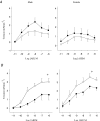Impaired EDHF-mediated vasodilatation in adult offspring of rats exposed to a fat-rich diet in pregnancy
- PMID: 15194731
- PMCID: PMC1665032
- DOI: 10.1113/jphysiol.2002.018879
Impaired EDHF-mediated vasodilatation in adult offspring of rats exposed to a fat-rich diet in pregnancy
Abstract
We recently reported vascular dysfunction in adult offspring of rats fed a fat-rich (animal lard) diet in pregnancy. This study reports further characterization of constrictor and dilator function in mesenteric and caudal femoral arteries from 180-day-old offspring of dams fed the high fat diet (OHF). Endothelium-dependent relaxation in response to acetylcholine (10(-9)-10(-5)m) was impaired in mesenteric small arteries from male and female OHF compared with offspring of dams fed normal chow (males (maximum percentage relaxation): OHF 67.92 +/- 2.89, n= 8 versus control 92.08 +/- 2.19, n= 8, P < 0.01). Substantial relaxation in response to acetycholine in control mesenteric arteries remained after inhibition of nitric oxide synthase, soluble guanylate cyclase and cyclo-oxygenase but was blocked by 25 mm potassium. This component of relaxation, attributed to EDHF, was significantly reduced in OHF mesenteric arteries compared with controls. However, EDHF played a minor role in acetylcholine-induced relaxation in both control and OHF femoral caudal arteries (male and female). In these arteries, in contrast to mesenteric vessels, acetylcholine-induced relaxation was significantly enhanced in OHF but only in males (ACh (maximum percentage relaxation): OHF 58.40 +/- 4.39, n= 8 versus male controls 32.18 +/- 6.36, P < 0.05). This was attributable to enhanced nitric oxide-mediated relaxation. In conclusion, reduced endothelium-dependent relaxation in OHF mesenteric arteries is due to impaired EDHF-mediated relaxation. This defect was not apparent in femoral arteries in which EDHF has a less prominent role.
Figures





References
-
- Bauersachs J, Popp R, Hecker M, Sauer E, Fleming I, Busse R. Nitric oxide attenuates the release of endothelium-derived hyperpolarizing factor. Circulation. 1996;94:3341–3347. - PubMed
-
- Bolotina VM, Najibi S, Palacino JJ, Pagano PJ, Cohen RA. Nitric oxide directly activates calcium-dependent potassium channels in vascular smooth muscle. Nature. 1994;368:850–853. - PubMed
-
- Bonora E, Kiechl S, Willeit J, Oberhollenzer F, Egger G, Bonadonna RC, Muggeo M. Metabolic Syndrome: epidemiology and more extensive phenotypic description. Cross-sectional data from the Bruneck Study. Int J Obes Relat Metab Disord. 2003;27:1283–1289. - PubMed
-
- Busse R, Edwards G, Feletou M, Fleming I, Vanhoutte PM, Weston AH. EDHF: bringing the concepts together. Trends Pharmacol Sci. 2002;23:374–380. - PubMed
-
- Bussemaker E, Popp R, Fisslthaler B, Larson CM, Fleming I, Busse R, Brandes RP. Aged spontaneously hypertensive rats exhibit a selective loss of EDHF-mediated relaxation in the renal artery. Hypertension. 2003;42:562–568. - PubMed
Publication types
MeSH terms
Substances
LinkOut - more resources
Full Text Sources
Medical

